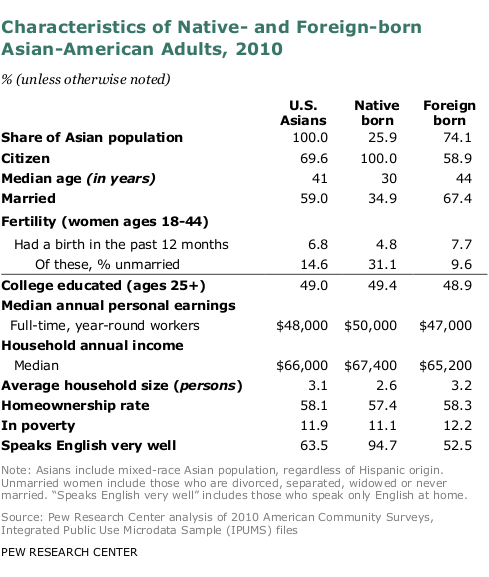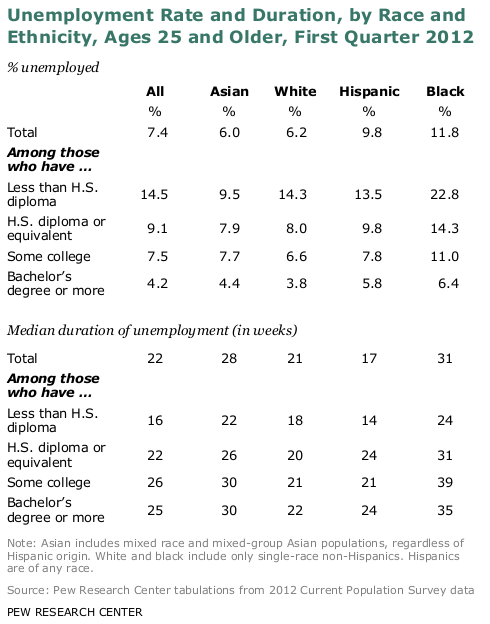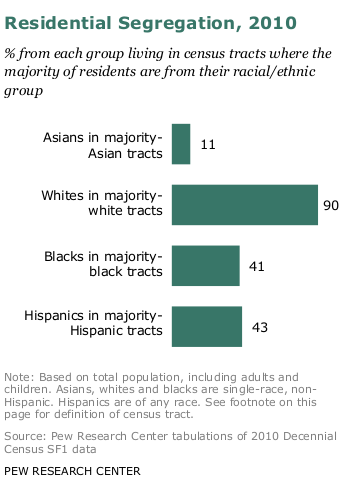The recent report released last month by the Pew Research Center entitled “The Rise of Asian-Americans” has undoubtedly spawned much discussion. While looking at some of the conclusions provided by the report, the extrapolated data presented several trends that would probably be surprising to most readers. As a side note, it is not my intention to provide a full summary of the report or the current discussion here. I have included a link at the end of this post to the full report for your perusal at your pleasure.
The focus of discussion among many Asian-American Christians concerning this report has been the general religious affiliation of each ethnic group – as summarized above. For the most part, the results of the report fit generalizations that most Asian-Americans involved in ministry have had in the recent past. For example, it is of little surprise that a significant number of Korean-Americans self-identify as Protestant. However there are other data points contained within the report that certainly need to be discussed and analyzed. To focus solely upon key demographic features found in the table above and the fact that Asian-Americans are now the fastest growing ethic group as noted by the 2010 census, would miss extremely important sociological patterns that we simply cannot ignore.
As identified in the table above, nearly 74.1% of all Asian-Americans in 2010 were foreign-born. As a whole, it is also notable that only 63.5% of Asian-Americans were identified as proficient English speakers. Even more striking is the identification of only 43% of foreign-born adult Koreans as proficient English speakers in this report. With this data in mind, we must undoubtedly recognize that ministries for first-generation Asian immigrants are here to stay. Although immigrant churches have been decried as inherently sinful by some prominent individuals, it is an undisputed fact that the majority of English-speaking churches in the United States are neither structured nor equipped to effectively minister to recent immigrants. Until significant change has occurred, it is not feasible to realistically expect non-English speaking immigrants to attend the average American church in large numbers when resources for language and cultural transition are not provided. Another implication of this data is that over the years I have spoken to many well-meaning first generation pastors where they have reported to have structured their church with the expectation of the rise of the second generation congregation and eventual decline of the first generation ministry. Based upon current demographic data, this event will most likely not occur for many Asian immigrant churches as the rate of immigration seemingly far exceeds the birthrate of Asian-Americans at the present time. The report in many ways substantiates the necessity of Asian immigrant churches. With the statistic of only 52.5% foreign born Asian-Americans being proficient English speakers alone – not to mention the added presence of racism, it would be extremely difficult for a significant majority of Asian-American immigrants to become connected intimately with a non-immigrant church. This experience is also echoed by many American ex-patriot believers who often find themselves gathered together in worship in foreign countries. I would be hard pressed to state that such gatherings should be disbanded.
Unlike my opinion regarding first generational ministries, the report does cause me to personally question the current state of ethnic specific ministries for second-generation Asian-Americans. With only 25.9% of the Asian-American US population being native-born, this would mean that even a second generation pan-Asian ministries would only seek to minister to approximately 1.4% of the US population. With this in mind, the sphere of influence of Asian ethnic specific ministries for second generation Asian Americans could be assumed to be less than 1% in the United States as a whole. While some may argue that there are regions of the United States that are heavily populated with Asian-Americans, the argument is a bit moot as Asians only consist of 14.92% of California’s population – the most heavily concentrated state within the contiguous US of Asian-Americans. Without a doubt such ministries contribute to statistics such as 58% of Koreans report that the majority of their immediate social circle is composed of individuals who are also Korean. I propose this statistic can be expected to be much higher among Asian-American Christians who are involved in their ethnic specific local church or para-church ministries – especially ministries where the church culture expects individuals to be present at a high percentage of functions and events. Because of such tight-knit social circles, the effects of this can be seen in a diminished ability for many second-generation Asian-Americans to network professionally and also engage comfortably with culture at large. This can be most clearly seen in the median duration of unemployment during the First Quarter of 2012, as shown below. While the median duration of unemployment of all Americans with a bachelor’s degree or higher was around 25 weeks long, Asian-Americans with degrees in higher education had a median unemployment duration that was close to 1.5-2 months longer than the average duration of unemployment. This discrepancy is extremely significant as professional and personal networking is still the primary means of finding a job among Americans today – even in the age of online job postings.
While second generation Asian-Americans have often been hailed to possess a bi-cultural identity that is helpful in evangelism, it can be assumed that only a minority of Asian-American believers are currently engaging others outside their ethnicity based upon this report. This is certainly problematic and brings forth the question of the viability of multiple long-term self-sustaining second-generation Asian-American churches in the same regional location outside of the Western regions of the United States if the focus is upon such a small percentage of the US population. Make absolutely no mistake, the issue at hand for many second generation Asian-Americans is not a matter of numbers. Scripture is very clear that God is very much concerned about each and every lost sinner that repents as shown in Luke 15:
[15:1] Now the tax collectors and sinners were all drawing near to hear him. [2] And the Pharisees and the scribes grumbled, saying, “This man receives sinners and eats with them.” [3] So he told them this parable: [4] “What man of you, having a hundred sheep, if he has lost one of them, does not leave the ninety-nine in the open country, and go after the one that is lost, until he finds it? [5] And when he has found it, he lays it on his shoulders, rejoicing. [6] And when he comes home, he calls together his friends and his neighbors, saying to them, ‘Rejoice with me, for I have found my sheep that was lost.’ [7] Just so, I tell you, there will be more joy in heaven over one sinner who repents than over ninety-nine righteous persons who need no repentance.
(Luke 15:1-7 ESV)
However as Asian-Americans even though we have the lowest probability of all other major ethnic groups of living in racial/ethnic tracts (11%), there is indisputable statistical evidence that points to our preference towards racial isolation when considering the table below and everything else that has been mentioned above:
To be absolutely clear, I am not saying that it is sinful to be part of a predominately Asian-American congregation and please do not misunderstand that I am writing as though such issues are entirely unique to Asian-Americans – they are most certainly not. However, in face of such evidence we must look hard at ourselves and consider whether or not we as a collective whole have made our ethnic and/or cultural identities an idol within our hearts – lest we become like the lawyer who hopes to justify himself in Luke 10.
[29] But he, desiring to justify himself, said to Jesus, “And who is my neighbor?” [30] Jesus replied, “A man was going down from Jerusalem to Jericho, and he fell among robbers, who stripped him and beat him and departed, leaving him half dead. [31] Now by chance a priest was going down that road, and when he saw him he passed by on the other side. [32] So likewise a Levite, when he came to the place and saw him, passed by on the other side.
(Luke 10:29-32 ESV)
As second-generation Asian-Americans, when we read the parable of the Good Samaritan, we absolutely must recognize that we are often the most akin to the priest and the Levite than anyone else in the parable. There are undoubtedly many individuals in need within our communities that we simply pass by without a second thought. Like the priest and the Levite in the parable, we also often justify this with our prior religious commitments. In our case instead of avoiding the necessity of purification rituals, many of us have prioritized our fellowships and personal lives. In many ways it is certainly good to recognize that we are often ill-equipped to provide substantial and beneficial aid to absolutely everyone, however we ought to recognize that our hearts tend to gravitate towards the whole and the beautiful, rather than the broken and blemished. In all honesty, even as a counselor my own heart gravitates towards the whole and the beautiful rather than the broken and blemished. Yet within this place of shame we find that we all need Jesus more than we think. I need Jesus more than I think. Deep down as Asian-American believers we must recognize and possibly repent over the fact that we have most often chosen to love individuals while ignoring the people who have lived closest to us. This is absolutely significant in light of 1 Cor 12:
The eye cannot say to the hand, “I have no need of you,” nor again the head to the feet, “I have no need of you.” On the contrary, the parts of the body that seem to be weaker are indispensable, and on those parts of the body that we think less honorable we bestow the greater honor, and our unpresentable parts are treated with greater modesty, which our more presentable parts do not require. But God has so composed the body, giving greater honor to the part that lacked it, that there may be no division in the body, but that the members may have the same care for one another. If one member suffers, all suffer together; if one member is honored, all rejoice together.
(1 Corinthians 12:21-26 ESV)
As Asian-American believers we need to ask, “In what ways do we desperately need believers of other ethnicities?” Simultaneously, we also need to consider in what ways are we as Asian-Americans indispensable to the majority culture.
Pew Research Center (2012). The Rise of Asian Americans. Retrieved from http://www.pewsocialtrends.org/2012/06/19/the-rise-of-asian-americans/


